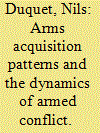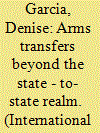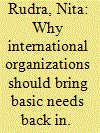|
|
|
Sort Order |
|
|
|
Items / Page
|
|
|
|
|
|
|
| Srl | Item |
| 1 |
ID:
087995


|
|
|
|
|
| Publication |
2009.
|
| Summary/Abstract |
Arms acquisition is a crucial venture for armed insurgency groups for carrying out their militant activities. I argue that the specific manner in which these groups obtain weapons may have important consequences for the dynamics of violent intrastate conflict. While most previous studies of the relationship between arms acquisition and armed conflict have focused solely on the impact of arms availability, in this article I analyze the impact of two specific aspects of arms acquisition patterns-the methods and the degree of leadership control-on the dynamics and nature of armed conflict in a qualitative case study of the armed conflict in the Niger Delta (Nigeria) between 1995 and 2005. I conclude that the specific arms acquisition method and the degree of leadership control over this process have strongly affected the dynamics of the conflict.
|
|
|
|
|
|
|
|
|
|
|
|
|
|
|
|
| 2 |
ID:
087994


|
|
|
|
|
| Publication |
2009.
|
| Summary/Abstract |
Arms transfers beyond the state-to-state realm can have harmful effects for international security dramatically affecting the relations and behavior of states. This article examines why an emerging international norm on "prohibiting states to transfer arms to nonstate groups" has failed to diffuse at the international level. It discusses the already available international law framework existing at the regional and international levels upon which the potential norm could be built. The failure of the norm to diffuse at the international level can be primarily explained by the existence of a long-consolidated norm: the customary practice of states to transfer weapons to nonstate actors, that is, groups they deem legitimate to, without any interference or constraint.1 The unrestrained transfer of weapons is an established foreign-policy practice. It is the way states form, uphold alliances, extend friendships, and build spheres of influence (Sorokin 1994). Clearly, no state willingly wants to give this up. Therefore, the multilateral agreement on a norm barring most or all transfers of weapons to nonstate actors would curtail the freedom of action to build spheres of influence as states please. There are genuine ethical and moral dilemmas in this discussion, a nonstate actor may be a freedom fighter or a terrorist depending on different perspectives. The distinction between the categories "state" and "nonstate" actors may risk classifying actors in two camps: the good and the bad, respectively. This is problematic as a few states are known to be the most brutal perpetrators of egregious violations against their own citizens, whereas certain nonstate actors are legitimately fighting for the protection of vulnerable populations.
|
|
|
|
|
|
|
|
|
|
|
|
|
|
|
|
| 3 |
ID:
087998


|
|
|
|
|
| Publication |
2009.
|
| Summary/Abstract |
This paper details one attempt to construct an introductory course in international relations and comparative politics that does not rely upon one of the many textbooks in the field. This course description seeks to introduce students to global issues without reproducing and reifying a particular way of being in the world. It achieves this curatorial effect by exploring 11 concepts in the context of 11 books. There are both significant advantages and disadvantages to this approach. While the course is a lot more work for everyone, risks privileging breadth over depth, the results of this pedagogical method are opinioned to be remarkable and rewarding for both the student and the professor.
|
|
|
|
|
|
|
|
|
|
|
|
|
|
|
|
| 4 |
ID:
087992


|
|
|
|
|
| Publication |
2009.
|
| Summary/Abstract |
Written prior to the release of the UN Secretary-General's report on implementing the Responsibility to Protect (R2P), this article examines the effort to translate the principle from words into deeds. It begins by noting a post-2005 "revolt" against the principle in which a number of states expressed skepticism about the principle and its use in different settings. This revolt, the article contends, was largely a product of the continuing association between R2P and humanitarian intervention. This association was, in turn, caused by a combination of misplaced commentary and the International Commission on Intervention and State Sovereignty's focus on the intervention question. This article maintains that building consensus on the R2P requires a shift in emphasis and proposes three avenues: clarifying the nature of prevention, developing practical measures, and proposing modest proposals for institutional reform.
|
|
|
|
|
|
|
|
|
|
|
|
|
|
|
|
| 5 |
ID:
087999


|
|
|
|
|
| Publication |
2009.
|
| Summary/Abstract |
International studies (IS) programs have proliferated across campuses over the past decades. Given the increasing ubiquity of IS education, as well as the interdisciplinary nature of IS, most previous scholarship on IS programs has focused on issues of curricular structure. Yet there is a lack of systematic information on many key issues facing IS programs. Through a survey of directors of these programs, this study seeks to examine some of the broader issues surrounding IS as a field of undergraduate study. In particular, I examine student popularity of our programs, the various ways in which they are administratively structured, and the perceived stature of IS programs within home institutions. Additionally, some of the factors that contribute to growth in IS programs are examined. The overall goal of this study is to provide a "first step" towards building a comparative assessment and benchmark of the institutional and administrative characteristics of IS programs.
|
|
|
|
|
|
|
|
|
|
|
|
|
|
|
|
| 6 |
ID:
087997


|
|
|
|
|
| Publication |
2009.
|
| Summary/Abstract |
This paper presents an active learning module design and implementation strategy for use in an undergraduate course on globalization, world politics, international political economy, or international relations. Students are first asked to conduct research on their wardrobe and its origins by country, allowing for classroom discussion of research methods and designs. Results are submitted, along with a short response essay. This is evaluated in conjunction with a case-study short reading and shared discussion, followed by a short video/multimedia presentation on free trade and labor issues. Drawing on literature on active learning, I argue that this presents a more cohesive approach for engaging students in the material on a substantive level, while at the same time allowing them to actively appreciate and understand such diverse concepts as commodity chains, free trade zones, fair trade versus free trade, gendered divisions of labor, consumer responsibility, research methodologies, and macroeconomic shifts in employment across nations. This also serves as a rubric for instructors to use in creating their own topical "modules." Preliminary data and classroom results are discussed, as are additional strategies for lesson development.
|
|
|
|
|
|
|
|
|
|
|
|
|
|
|
|
| 7 |
ID:
087993


|
|
|
|
|
| Publication |
2009.
|
| Summary/Abstract |
An important milestone in the development debate is the recognition of poverty as a multidimensional phenomenon via the capabilities approach. However, a challenge remains in that many governments in less-developed countries continue to avoid prioritizing issues of absolute deprivation. This paper demonstrates how and why existing efforts to operationalize capabilities may distract policy makers from giving sufficient weight to issues of basic survival. We propose that international organizations can address this challenge through a method of triangulation: (1) identify how countries rank on universal goals of human development; (2) identify how countries rank on universal goals of basic needs provision; and (3) promote participatory poverty assessments. This approach ensures that absolute deprivation issues are addressed, and it establishes an acceptable (and necessary) balance between standardization and local complexity.
|
|
|
|
|
|
|
|
|
|
|
|
|
|
|
|
| 8 |
ID:
087996


|
|
|
|
|
| Publication |
2009.
|
| Summary/Abstract |
How news coverage is affected by dangerous security environments is an important issue for political scientists who rely upon journalistic accounts of political events. It is also a controversial issue in the policy arena. In June of 2004, Deputy Defense Secretary Paul Wolfowitz attributed the American public's pessimism regarding U.S. efforts at stabilizing Iraq to the manner in which Iraq was covered by the U.S. media, suggesting that journalists in Iraq were holed up in hotels rather than in the field. This statement was conjecture, but if there is indeed a link between news coverage and violence, then this would be important for social scientists to understand. In this article, I probe this link by examining how conflict intensity and journalist deaths affect both the volume and length of news coverage in civil wars from 1992 to 1999. This paper shows that news coverage is largely unaffected by violence, except in the most extreme circumstances.
|
|
|
|
|
|
|
|
|
|
|
|
|
|
|
|
|
|
|
|
|